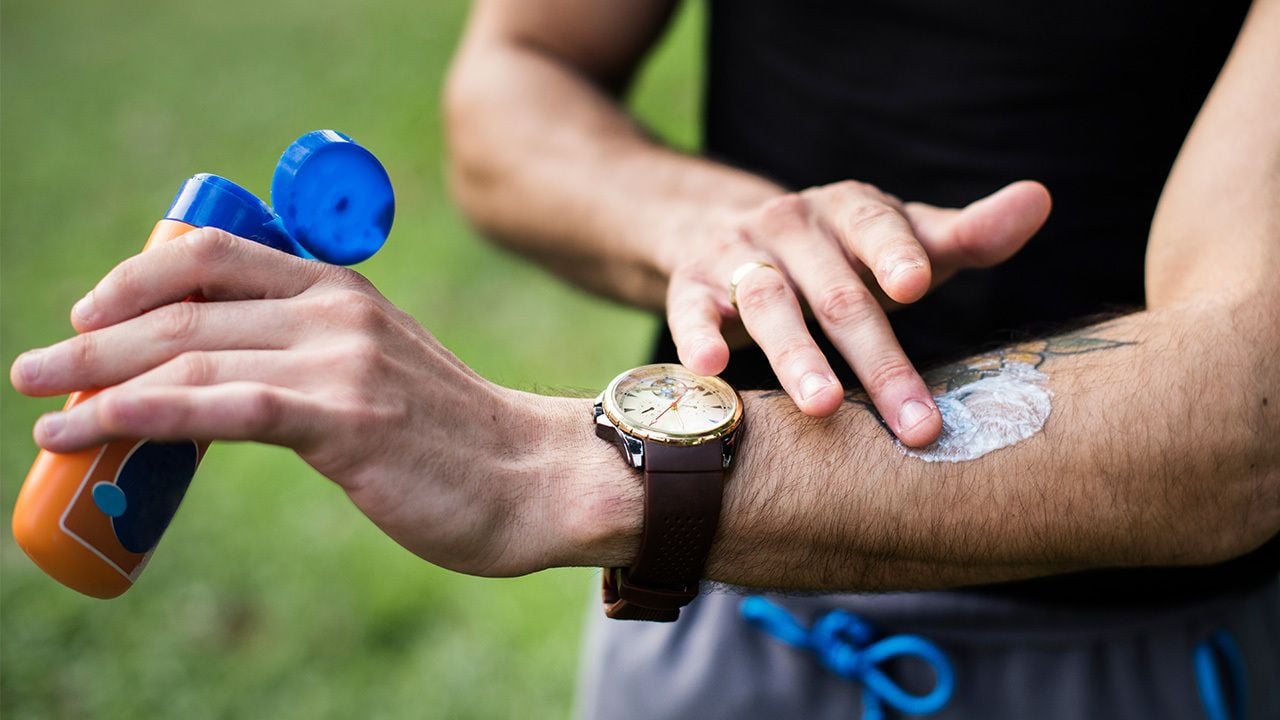
The start of spring means longer days, stronger UV rays, open windows and spring cleaning. Here are a few tips EWG suggests for safely enjoying the season.
Use safe and effective sun protection
The sun’s rays are linked to skin damage and cancer. To protect yourself, it’s important to adopt good sun safety practices: Cover up, seek out shade, plan around the hottest times of the day and regularly use a safe and effective sunscreen.
Many sunscreens manufactured in the U.S. contain ingredients linked to health harms, like oxybenzone, a hormone-disrupting chemical, and do not adequately protect from both ultraviolet A and B rays. To find the best sunscreens, consult EWG’s Guide to Sunscreens, including our tips for reducing sunburn risk. And remember that SPF products break down and become less effective over time, so it’s important to reapply them every few hours.
Clean up your beauty routine
Spring is the perfect time to clean out your stash of personal care products.
First, get rid of old or expired products. You might be surprised to learn that personal care products can go bad, and there is a period of time after which a product shouldn’t be used anymore, whether because of increased risk of bacterial contamination or changes in other qualities. You can find expiration dates on most product labels, even though they’re not required by the Food and Drug Administration.
For products without expiration dates, you’ll have to decide whether a product should be thrown out based on how long ago it was opened or obvious signs that the formulation has turned, such as smell. Many authorities suggest disposing of products after a few months to two years, depending on the product type.
Cleaning your makeup brushes regularly, washing your hands before application and keeping products out of direct sunlight can help them from trapping bacteria and spoiling early.
To see whether products you’re keeping contain ingredients linked to health concerns, consult EWG’s Skin Deep® database. If they do contain problematic ingredients, look for safer replacements. Pro tip: Products with the EWG VERIFIED® mark are a good bet – they meet our strictest standards for health and transparency.
If you have unused or gently used unexpired products you no longer want, consider donating them to organizations like Project Beauty Share, or contact your local homeless shelter to see whether they accept donations of unused products.
Limiting the number of products you use is a good way to reduce the number of chemicals you’re exposed to. Best bet: Consult Skin Deep and EWG VERIFIED before you add a new product to your routine. Our Healthy Living App makes that easy to do on the go.
Take care of allergies
If you suffer from spring allergies, you’re likely familiar with outdoor triggers that worsen your symptoms, but you may be less familiar with indoor allergens and pollutants.
The air inside can be two to five times more polluted than the air outside. Indoor pollutants – including dust, pollen, animal dander, mold and smoke – can worsen health conditions like asthma and respiratory irritation and lead to more serious long-term consequences, such as lung disease and cancer.
For instance, indoor dust samples in a new study contained “hormonally active compounds.” These compounds are most closely associated with PFAS and PBDE, a flame retardant that can be found in some furniture. Both have been linked to serious health issues.
Although no air filter alone will fully clean the air, you can improve air quality with filters installed in your central heating and cooling system, or with a portable air purifier.
To make sure dust and other allergens don’t accumulate, you’ll need to do some spring cleaning. First, take a look at the products you use. Many conventional cleaners contain harsh or toxic chemicals that can harm your family's health. EWG’s Guide to Healthy Cleaning makes it easier to avoid those products, and EWG VERIFIED helps you find cleaning products that meet our strictest standards for health and transparency.
The EWG Healthy Living: Home Guide addresses how to keep yourself and your family safe from everyday toxicants in your home.
Eat seasonally
This is a great time to find out what produce is in season near you. Fruits and vegetables are typically fresher and tastier when harvested and consumed at their peak maturity – and thus most “health promoting” – according to the Center for Excellence in Fruit and Vegetable Quality at the University of California, Davis. Produce begins to lose its nutritional value when it’s harvested. Fruits and vegetables grown at home or bought locally and in season require less transportation and storage, as well as less irrigation and fewer pesticides.
The Seasonal Food Guide can help you get started eating in season – it lets you filter by state and month to show where and when your favorite locally grown produce is at its peak. Shopping at a farmers market and talking to vendors are also great ways to learn what’s in season.
Consult EWG’s Shoppers Guide to Pesticides in Produce™ to reduce your exposure to toxic pesticides: The Dirty Dozen™ to find out which fruits and vegetables we recommend you buy organic, and the Clean Fifteen™ for those you can safely buy non-organic.
Make sure your lawn and garden are non-toxic
It’s best to keep pesticides away from your home, inside and out. Pesticides used at home are a significant source of exposure, and since they’re designed to kill living organisms, they can (not surprisingly) be dangerous to your health. Fertilizers can be especially toxic to your lawn, the environment and your health when used excessively.
This season, consider the alternatives – organic gardens, lawns and landscaping requiring no pesticides and little or no watering. Talk to a local garden center or nursery about the best kind of grass to grow in your area, keeping in mind that mixed-species and native wildflower lawns are a low maintenance alternative to turfgrass that also put less strain on the local ecosystem.
Get active
Physical activity is vital to good health, and warmer weather brings more opportunities to pursue it outside.
The Centers for Disease Control and Prevention says that children and adolescents ages six to 17 need at least 60 minutes of moderate to vigorous physical activity every day, whereas adults need 150 minutes of moderate activity per week.
A brisk walk or bike ride is a great way to meet daily activity goals. Gardening, yard work and household chores are also healthy physical activities. However you decide to get moving, any physical activity is better than none.


